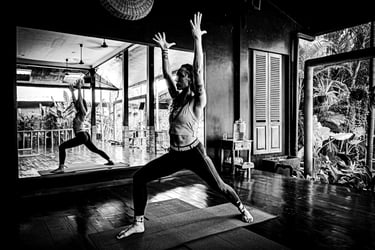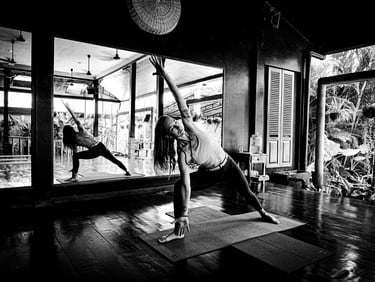Drained After Yoga
Yoga Vitality
Yoga, practised with awareness and appropriate guidance, should never be draining. Its very essence is to cultivate vitality (prāṇa) and bring the body and mind into a state of optimal balance. If you consistently finish practice feeling exhausted, it's a signal to investigate further – not something to be passively accepted as a by-product of “releasing”.
The notion that “releasing tensions” must be tiring can be misleading. While emotional and physical release can occur, a skilled practice integrates this process so that the body's energy is transmuted and circulated – not simply discharged. The goal is rejuvenation, not collapse.
Exposing Existing Fatigue
Our lives are often filled with distractions, keeping our minds busy and masking just how truly exhausted we are. We push through chronic sleep debt, relentless stress, and poor nutrition, relying on external stimulation to keep going. Yoga – with its emphasis on slowing down, deep breathing, and mindful attention to internal sensation – strips away these distractions. When the external noise quietens, your body’s subtle, pre-existing signals of fatigue – which you might have ignored or suppressed – suddenly become impossible to overlook.
It’s not that yoga made you tired; it made you aware of your underlying exhaustion. This realisation, though initially uncomfortable, is a vital step towards genuine rest and recovery.
Yoga is celebrated for its ability to reduce stress, increase flexibility, and foster inner peace. Yet a common experience among some practitioners is feeling inexplicably tired – even drained – after a class. While the popular explanation often boils down to “releasing tensions and emotions”, this answer, though partially true, significantly oversimplifies the matter. In fact, a well-executed yoga practice should leave you feeling refreshed, energised, and balanced – not depleted.
So why the fatigue? The answer lies in a deeper understanding of our nervous system, the quality of our energy reserves, and the art of proper yoga sequencing.
Running on Empty
Even a gentle yoga class requires a degree of physical and mental engagement. If your energy reserves are already critically low – like an overdrawn bank account from chronic lack of sleep, insufficient nourishment, or persistent stress – any exertion, however mild, may push you further into depletion. Yoga helps you use and cultivate your existing energy more efficiently, but it cannot conjure energy from nothing. Attempting to practise when your well is dry will only lead to deeper fatigue.
The "Crash" : A Nervous System Shift
Many of us live in a state of chronic sympathetic nervous system activation – the "fight or flight" mode. This heightened alertness consumes energy rapidly. Yoga, especially through breathwork and present-moment awareness, activates the parasympathetic nervous system – our "rest and digest" mode.
For a system unaccustomed to such deep relaxation, this sudden downshift can feel like a crash. It's similar to the immense fatigue you might feel after a stressful period finally subsides. This temporary tiredness is not necessarily negative; it signals that the body is beginning the long-overdue process of repair, recovery, and restoration.




Remaining Engaged Without Stress
A key, often misunderstood, concept in yoga is active rest. In a skilfully guided class, rest does not mean collapse. Rather, it involves maintaining a state of engagement without triggering the stress response.
This stress response is what drains you. When the body enters “fight or flight,” it releases energy-burning hormones like cortisol and adrenaline, speeds up metabolism, and suppresses restorative functions. Sustained activation is deeply fatiguing.
In an effective yoga class, even challenging poses are approached with an intention of ease and breath. A skilled teacher guides you to remain active – meaning mindful and engaged – rather than collapsing. This careful pacing helps to:
Prevent overexertion: Encouraging students to recognise and honour their limits.
Facilitate gradual transition: Easing the nervous system into deeper relaxation, rather than forcing it.
Support internal regulation: Helping students develop awareness of their own energy and nervous system states, cultivating integration instead of disorientation.
This approach ensures that even a physically (sometimes sweaty), class can be invigorating. While sweating is never the aim of yoga – mindfulness, breath, and inner balance are – the physical exertion, when paired with conscious breath and release from the stress response, becomes a catalyst for circulating energy and cleansing the system, rather than depleting it. The result is a feeling of robust, clean energy – not exhaustion.
If you consistently feel drained after yoga, take it as an invitation to listen more deeply to your body.
Consider:
Your starting energy levels: Are you entering class already depleted?
The quality of guidance: Are you being supported to find active rest and minimise unnecessary tension?
A well-rounded yoga practice should empower you with greater energy, clarity, and inner peace. By understanding the true mechanisms behind post-yoga fatigue, we can move beyond simplistic narratives and cultivate a practice that nourishes us – not just physically, but energetically and emotionally, from the inside out.
More Insights
